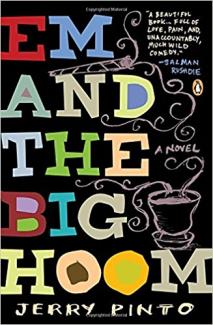
In the book Em and the Big Hoom, Jerry Pinto takes the reader right into the heart of the Mendeses family which reels and recovers as it tries to cope with the mental illness of its central character. A book report by Shwetankshi Bhuwalka (A Psychology Major, School Teacher, and Avid Reader)
They say the greatest books are the ones you don’t want to end. You want to continue reading it for as long as you can and it becomes a part of your world. I finished reading the book a couple of days ago, but when alone and thinking, I found myself thinking about Em and Hoom. The world of Em and Hoom is one such world that captivates your interest and makes you watch from the sidelines: least you get sucked into it. This is the story of Mumbai, in a microcosm. Though all seems well from the outside, it’s a raging mess of emotions that only the people living inside understand.
The book is about Imelda and Augustine. Referred to as Em and Hoom affectionately by their children, a daughter- Susan and the unnamed son who is the narrator of the story. A Christian family, they live in a 1 BHK in Mahim. Em is the mother all of us wish we had during our teenage years. One who could talk of things that were not supposed to be discussed, smoke bidis and treat the children as if they were much older than they actually are. A frequent visitor of Ward 33, (Psychiatric) Sir J. J. Hospital, Em suffers from a mental illness that oscillates between a darkness fuelled by suicide attempts to profound chats about the world and incisive insights into the working of life. Though not specified, Em does suffer from a mental disability. She hallucinates about her family being in some kind of trouble and delves in the deep dark schism of depression often. And then Hoom, the patriarch of the family, who is the loom on which this story is weaved. He is the rock, the unfazed father who takes all things that life throws at him with a stoic belief and love for his wife.
That is what it is at heart – a love story – between Em and Hoom and their unquestioning acceptance of each other. It is a story of a son, a “son of a mad woman” seeking to find answers to the reason of his mothers ‘madness’ in a quest to chart his own destiny. He wonders, believably, whether he too will go through what the mother is going through.
Here, Pinto talks about a concept unheard of in India, a support group for the caregivers. It is a tiring responsibility knowing that you could be pulled out of whatever you are doing because your mother might have had one of her phases. When the son wants to create a support group, the people are most interested in figuring out if they can leave the unwell family members with him for a couple of hours.
For a first novel, Jerry Pinto is able to describe the working of a mind inflicted with anguish almost beautifully. The highs and lows are described so poignantly it touches a nerve. Though the hero, or in this case heroine, is Em, Jerry Pinto is able to describe the pain and hurt that every member of the family feels. The book understands and empathizes with the family as they trudge throu life taking their suffering mother along. It's never easy juggling between flashbacks and the present, but it seems as if Jerry Pinto is a master at it. The move between the letters describing the vintage pretty love life of the parents to the gritty present is almost as seamless as can be. When reading the letters, one is almost curious to know know what Em would be doing then and when reading about the present, the urge to know more details about Em’s past is overwhelming. Halfway into the book you almost start anticipating the gloom the illness is going to bring and the euphoria it is going to spread a little while later.
In parts funny, dark and sorrowful, this book transports the reader into the crazy world of the Mendeses where the reader becomes a voyeur. And enjoys a bottle of Old Monk and garlic chicken dry.
We recommend the book for its honest portrayal of a family affected by mental illness and one of the first such books written in India.






